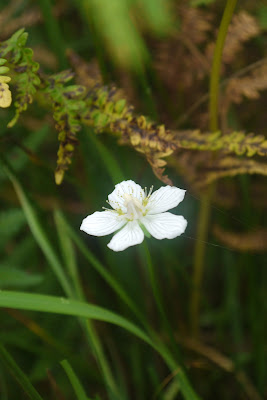Last week I was on holiday in the Lake District with my partner Chris and his parents. We go there pretty much every year and always have a great time, walking in the hills and valleys and enjoying the wildlife. As always I was on the look out for new plants to try and identify, and although autumn was in the air we were still able to find plenty. Chris's mum Dawn is a wildflower fan also so we had fun trying to identify what we'd found!
I spotted the most new plants on the very first walk we did, which was from our cottage in Stonethwaite over to Watendlath and back again. It had been raining heavily in the morning but luckily by the afternoon it had pretty much stopped, although was still rather grey.
 |
| Looking down to Watendlath. |
As well as new plants, I enjoyed trying out my camera on some old favourites. I'm a big fan of the heather triumvirate!
 |
| Bell Heather (Erica cinerea). |
 |
| Cross-leaved Heath (Erica tetralix). |
 |
| Heather (Calluna vulgaris). |
 |
| Lots of lovely heather on this walk. |
And also the cute buds of Devil's-bit Scabious:
 |
| Devil's-bit Scabious (Succisa pratensis). |
On to the new ones....I hope I got the identifications correct for these:
 |
| Bog Myrtle (Myrica gale). Lots of this growing on certain parts of the hills between Dock Tarn and the path down to Watendlath. |
 |
| Grass-of-Parnassus (Parnassia palustris). Nearly missed this hiding away in undergrowth beside the path. |
 |
| Bog Asphodel (Narthecium ossifragum). I'd seen lots of the orange seed pods on walks around the same time last year, but hadn't found any still in flower until now. |
We also found a patch of orchids, but we found another much bigger and better patch of orchids on another walk, coming down a valley towards Seathwaite after descending Great Gable. I think they were all Heath-spotted Orchids, but I'm not very sure!
 |
| Heading down the valley. |
 |
| Heath-spotted Orchid (Dactylorhiza maculata), possibly. |
 |
| Heath-spotted Orchid (Dactylorhiza maculata), possibly. |
 |
| Heath-spotted Orchid (Dactylorhiza maculata), possibly. |
Next up, a blog post about the Lake District fauna we encountered :o)







































